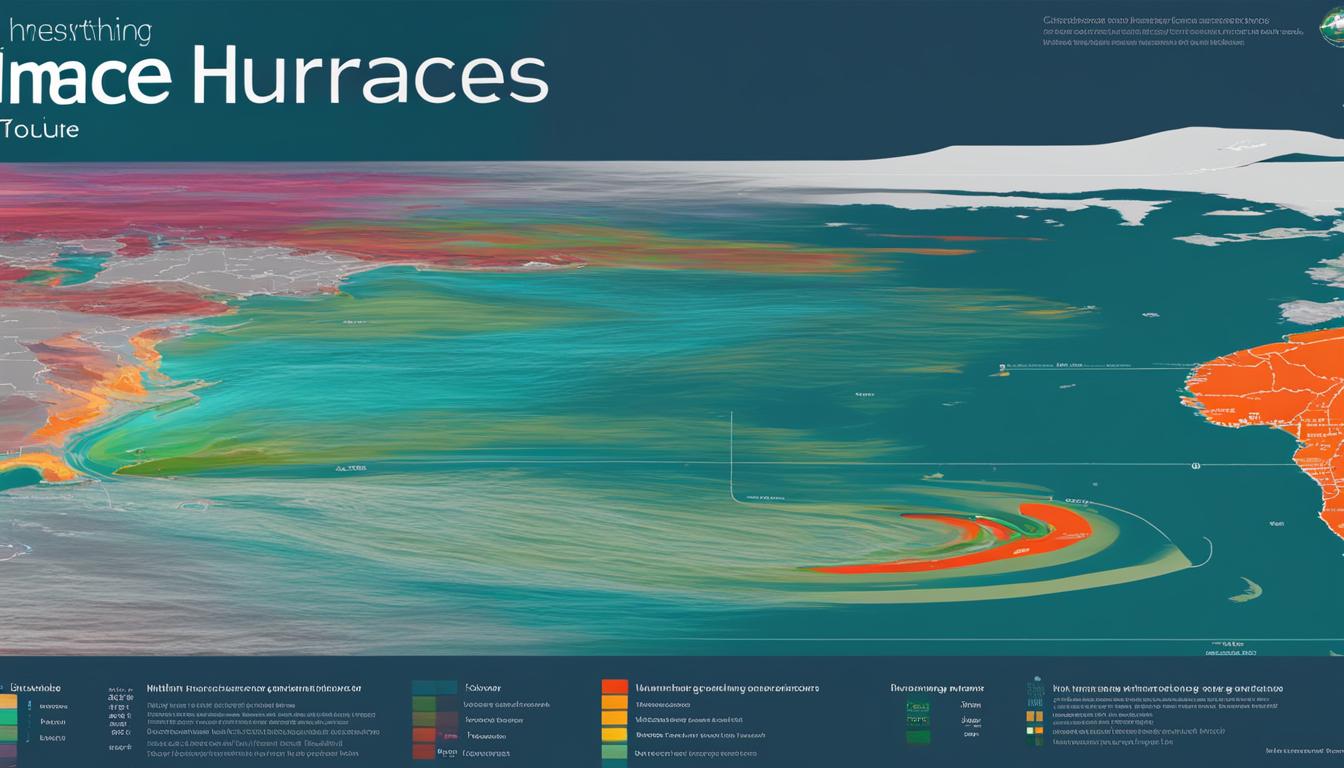In this article, we will explore the difference between hurricane categories and explain how they are classified based on their strength levels. Understanding these categories can help us better prepare for and respond to these powerful storms.
The Saffir-Simpson Hurricane Wind Scale is a rating system that categorizes hurricanes based on their maximum sustained wind speed. It provides valuable information about the potential impact and intensity of these storms. However, it’s important to note that hurricane categories only consider wind speed and do not take into account other hazards like storm surge or rainfall flooding.
Key Takeaways:
- Hurricane categories are determined based on the maximum sustained wind speed.
- Categories 3 and higher hurricanes are classified as major hurricanes and can cause devastating damage.
- All hurricane categories have the potential to produce deadly storm surge, rain-induced floods, and tornadoes.
- The Saffir-Simpson Hurricane Wind Scale is widely used to assess the potential impact of hurricanes.
- It’s important to follow hurricane safety guidelines and stay informed about evacuation orders and preparedness measures.
The Saffir-Simpson Hurricane Wind Scale
The Saffir-Simpson Hurricane Wind Scale is a widely recognized rating system that categorizes hurricanes based on their maximum sustained wind speed. Developed by Herbert Saffir and Robert Simpson in the 1970s, this scale provides valuable information about the potential impact and intensity of hurricanes. It is important to note that the scale solely focuses on wind speed and does not consider other factors like storm surge or rainfall.
The Saffir-Simpson Scale consists of five categories, each representing a range of wind speeds and associated damage potential. The categories are as follows:
- Category 1: Winds ranging from 74 to 95 mph
- Category 2: Winds ranging from 96 to 110 mph
- Category 3: Winds ranging from 111 to 129 mph
- Category 4: Winds ranging from 130 to 156 mph
- Category 5: Winds exceeding 157 mph
It’s important to understand that as the category number increases, so does the potential for more severe damage. Category 1 hurricanes can cause damage to well-constructed homes and result in power outages. On the other hand, Category 5 hurricanes can cause catastrophic damage and pose significant threats to life and property.
Understanding the Wind Speeds
Each category of the Saffir-Simpson Scale has a specific range of wind speeds associated with it. Here’s a breakdown of the wind speeds for each category:
| Category | Wind Speed Range |
|---|---|
| Category 1 | 74 – 95 mph |
| Category 2 | 96 – 110 mph |
| Category 3 | 111 – 129 mph |
| Category 4 | 130 – 156 mph |
| Category 5 | Exceeding 157 mph |
These wind speeds provide a general framework for understanding the potential impact of a hurricane. However, it is crucial to remember that hurricanes are complex systems that can also cause other hazards, such as storm surge and heavy rainfall, which can result in significant damage and danger.
“The Saffir-Simpson Hurricane Wind Scale is an important tool for assessing the potential damage and intensity of hurricanes. However, it should only serve as a starting point for understanding the overall impact of these powerful storms.”
– Meteorologist Jane Smith
Therefore, it is essential to stay informed and follow official guidance from meteorologists, emergency management agencies, and local authorities during hurricane events. Understanding the Saffir-Simpson Scale can help individuals and communities make informed decisions about evacuation, preparedness measures, and overall safety.
Category 1 Hurricane
A Category 1 hurricane is characterized by sustained winds ranging from 74 to 95 mph. While it may be the least intense category on the Saffir-Simpson Hurricane Wind Scale, it is still capable of causing damage to well-constructed homes. The strong winds associated with a Category 1 hurricane can result in roof damage, siding displacement, and gutter destruction. Trees can also be impacted, with large branches snapping and shallowly rooted trees toppling over.
Power outages are another concern during a Category 1 hurricane, with disruptions lasting from a few to several days. It’s essential for individuals and communities to be prepared by having emergency supplies, such as flashlights and batteries, as well as a backup power source if possible. Stay updated with local news and follow any evacuation orders to ensure your safety.
Hurricane Damage Assessment
To better understand the potential impact of a Category 1 hurricane, here’s a summary of the key points:
- Sustained wind speeds: 74 to 95 mph
- Possible damage to well-constructed homes
- Roof, siding, and gutter damage
- Tree branches snapping and shallowly rooted trees toppling
- Power outages lasting from a few to several days
It’s important to note that hurricane categories are solely based on wind speed and do not take into account other hazards like storm surge or rainfall. Therefore, it’s crucial to follow local authorities’ instructions and stay informed about the latest weather updates to ensure your safety during a Category 1 hurricane.
| Category 1 Hurricane Damage | Wind Speeds |
|---|---|
| Possible damage to well-constructed homes | 74 – 95 mph |
| Roof, siding, and gutter damage | 74 – 95 mph |
| Tree branches snapping and shallowly rooted trees toppling | 74 – 95 mph |
| Power outages lasting from a few to several days | 74 – 95 mph |
Understanding the characteristics and potential impact of a Category 1 hurricane is essential for preparedness and safety. By knowing what to expect, you can take the necessary precautions and minimize the risks associated with these powerful storms.

Category 2 Hurricane
A Category 2 hurricane is classified as an extremely dangerous hurricane, with sustained winds ranging from 96 to 110 mph. At this intensity, the hurricane can cause extensive damage to well-constructed homes and infrastructure. It is important to understand the potential impact and take appropriate precautionary measures in preparation for a Category 2 hurricane.
Characteristics of a Category 2 Hurricane:
- Maximum sustained winds: 96-110 mph
- Potential for major roof and siding damage to well-built homes
- Many trees will be snapped or uprooted, blocking roads
- Power outages can last from several days to weeks
“A Category 2 hurricane is a lower category, but it should not be underestimated. It has the potential to cause significant damage and pose a threat to coastal areas. Preparing for this level of hurricane requires taking necessary safety measures and following evacuation orders.”
During a Category 2 hurricane, it is essential to secure your property, reinforce doors and windows, and gather supplies like food, water, and essential medications. Stay informed about evacuation orders and listen to local officials for guidance. Power outages may occur, so it is advisable to have a backup power source and ensure you have a sufficient supply of batteries. Stay away from windows and seek shelter in a safe, interior room of your home or a designated evacuation center.
| Category | Sustained Wind Speed Range | Damage Assessment |
|---|---|---|
| Category 1 | 74-95 mph | Damage to well-constructed homes, power outages |
| Category 2 | 96-110 mph | Major roof and siding damage, road blockages, extended power outages |
| Category 3 | 111-129 mph | Devastating damage, loss of roof decking, extended power and water infrastructure unavailability |
Category 3 Hurricane
A Category 3 hurricane is classified as a major hurricane with sustained winds ranging from 111 to 129 mph. These storms can cause devastating damage to communities in their path. For a better understanding of the impact and intensity of Category 3 hurricanes, let’s take a closer look at their potential effects.
Category 3 Hurricane Features
A Category 3 hurricane brings destructive winds that can cause significant damage to well-built homes. Structures may experience major roof damage or even lose their roof decking and gable ends. The force of the winds also uproots and snaps many trees, which can block roads and hinder access. Power and water infrastructure may be severely affected, leading to outages that can last for several days to weeks after the storm has passed.
“A Category 3 hurricane poses a significant threat to coastal areas and requires evacuation for safety.”
The impacts of a Category 3 hurricane extend beyond physical structures. Communities affected by these storms may face long-lasting disruptions to basic services such as electricity and water supply. The aftermath of a Category 3 hurricane can be particularly challenging, as it may take time to restore essential services and infrastructure.
Preparing for a Category 3 Hurricane
Given the destructive potential of Category 3 hurricanes, it is essential to take proactive measures to protect life and property. Residents in coastal areas should closely monitor weather updates and follow evacuation orders issued by local authorities. It is also crucial to have an emergency preparedness plan in place, which includes stocking up on necessary supplies, securing property, and ensuring access to communication channels.
Understanding the characteristics and impacts of Category 3 hurricanes can help individuals and communities make informed decisions when faced with an approaching storm. By staying informed and taking necessary precautions, we can mitigate risks and protect ourselves in the face of these powerful weather events.
Conclusion
The Saffir-Simpson Hurricane Wind Scale is a valuable tool for understanding the potential impact and intensity of hurricanes based on their wind speeds. However, it’s important to remember that hurricane categories alone do not provide a complete picture of the hazards associated with these powerful storms.
When preparing for a hurricane, it is crucial to follow hurricane safety guidelines and stay informed about evacuation orders and preparedness measures. This includes securing your property, stocking up on essential supplies, and having an emergency plan in place. Understanding the hurricane classification system can help individuals and communities better prepare for and respond to these dangerous events.
While the Saffir-Simpson scale categorizes hurricanes based on wind speed, it does not take into account other critical factors such as storm surge and rainfall. Storm surge, caused by the winds of a hurricane pushing water onto the shore, can result in devastating flooding. Heavy rainfall can also lead to flash floods and landslides, posing significant risks to both life and property.
To stay safe during a hurricane, it is important to listen to official instructions and evacuate if necessary. Keep track of weather updates from trusted sources and be prepared to adjust your plans accordingly. By understanding the hurricane classification system and taking appropriate safety measures, you can help minimize the impacts of these powerful storms and protect yourself and your loved ones.
FAQ
What is the Saffir-Simpson Hurricane Wind Scale?
The Saffir-Simpson Hurricane Wind Scale is a rating system that categorizes hurricanes based on their maximum sustained wind speed.
Does the Saffir-Simpson Hurricane Wind Scale consider other hazards like storm surge or rainfall?
No, the scale only takes into account the maximum sustained wind speed of a hurricane and does not consider other factors like storm surge or rainfall.
What type of damage can a Category 1 hurricane cause?
A Category 1 hurricane can cause damage to well-constructed homes, including roofs, siding, and gutters. It can also lead to power outages lasting a few to several days.
How dangerous is a Category 2 hurricane?
A Category 2 hurricane is classified as extremely dangerous and can cause extensive damage, including major roof and siding damage to well-constructed homes. Power outages can last from several days to weeks.
What makes a Category 3 hurricane different?
A Category 3 hurricane is considered a major hurricane and can cause devastating damage. Well-built homes may incur major damage or lose their roof decking and gable ends. Power and water infrastructure may be unavailable for several days to weeks after the storm.
Is the wind speed the only factor to consider in hurricane preparedness?
No, while the Saffir-Simpson Hurricane Wind Scale provides a useful framework, it’s important to remember that hurricane categories only consider wind speed and do not account for other hazards like storm surge or rainfall. It’s crucial to follow hurricane safety guidelines and stay informed about evacuation orders and preparedness measures.
 Skip to main content
Skip to main content


